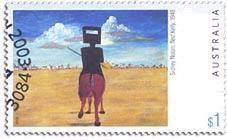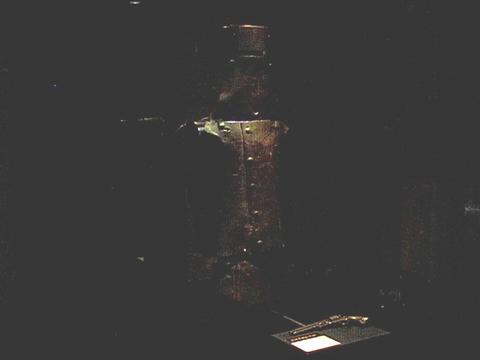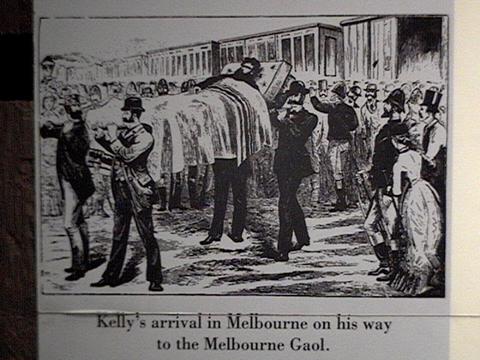
in dented armor, one arm extended, his gun in his hand. Bullets rang against
his armor as he walked slowly towards the police front line. They fell back
and on Kelly came"
On a cold June morning, more than 100 years ago a bushranger called Ned Kelly
fought his final battle.
He was an outlaw who rode a horse, put on a suit of armour and fought police.
Today, Ned Kelly is an Australian legend.
Ned, the eldest of eight children, was born to Irish parents in Victoria
in 1854.
He was just twelve years of age when his ex-convict father died and his
family settled near relatives at Greta, two hundred and forty kilometres
northeast of Melbourne.
In Ned's time it was wild, rugged country and life was hard.
The best land was held by a handful of wealthy so called squatters.
But Ned's family was poor and the only opportunity they had to own land
was as 'selectors'. Under the selection system families took up areas of land set aside by the
government and paid them off bit by bit.
As part of the scheme they also had to improve the property by clearing
it, building a house, putting up fences and growing a crop. If they didn't
the land could be taken away.
For many it was an impossible situation with the plots of land too small,
and the soil too poor for them to make a living.
Faced with poverty, selectors often stole horses and cattle from the wealthy
squatters.
Ned was just aged sixteen, when he was convicted of receiving a stolen horse
and served three years in gaol before being released in 1874.
Whether or not he was set for a life of crime is hard to say, but one event
had a dramatic effect on determining his future.
In April 1878, a police officer called Fitzpatrick accused Ned's mother
of attacking him and Ned of shooting him in the wrist.
The first feature film ever made shows a version of events in which Fitzpatrick
brings on the attack by assaulting one of Ned's sisters.
But whatever actually happened, the end result of Fitzpatrick's claims was
that Mrs. Kelly was sent to prison for three years and a one hundred pound
reward was offered for the capture of Ned.
From that time on Ned and his brother Dan kept to the bush.
On the 26 October 1878, together with friends, Joe Byrne and Steve Hart,
they came across police camped at Stringy Bark Creek.
Ned believed the police intended to kill him and Dan so he called on them
to surrender.
But three of the officers resisted, and in the fight which followed Kelly
shot them dead.
The reward for Kelly and his gang rose to two thousand pounds and would
later rise to an amazing eight thousand pounds, the equivalent, today, of
nearly two millions dollars!
But Ned had many supporters and for almost two years they helped the gang
dodge police.
During this time the Kelly gang robbed two banks.
The robberies were important in the making of the Kelly legend.
In defying authority, robbing the rich and by not taking any more lives
the gang fitted the popular image of brave and bold bushrangers.
The robberies also give us an idea of how Ned saw himself.
At each robbery he gave one of his hostages a letter in which he explained
to the government how he'd been persecuted by police.
He called Constable Fitzpatrick a liar and explained his killing of police
at Stringy Bark as self defence.
He also called for justice for the poor, writing...
"I have no intention of asking mercy for myself of any mortal man, or apologising,
but I wish to give timely warning that if my people do not get justice
and those innocents released from prison, I shall be forced to seek revenge
of everything of the human race for the future."
In June 1880 Ned made his last stand.
The Kelly gang was at the Glenrowan Hotel when they were surrounded by police.
Prepared to fight, the four bushrangers wore suits of armour made from
steel.
During the battle, Ned escaped through the police lines. But rather than
fleeing into the bush, he returned a number of times to fight police. He
was trying to rescue his brother and friends.
Eventually, he collapsed with more than twenty-eight bullet wounds to his
arms, legs, feet, groin and hands.
Beneath his armour a green sash he wore was stained with blood. It was a
sash he'd been given many years earlier for saving a drowning boy.
Ned was the only survivor of the siege. Joe Byrne had been shot early on
and after Ned's capture police set fire to the Inn and the charred remains
of Dan Kelly and Steve Hart were removed.
After Ned recovered he was convicted of the murder of one of the police
officers at Stringy Bark, and despite protests by thousands of supporters,
was sentenced to death.
years old.
Today Ned is everywhere. His giant form welcomes visitors to what is still
called Kelly Country, where every ten years the Glenrowan siege is reenacted.
For many, the making of Ned Kelly the legend, raises questions about how
Australians see themselves.
For some he's no more than a criminal but for others he continues to be
seen as brave and daring and , a bit of a larrikin, someone distinctly Australian.

